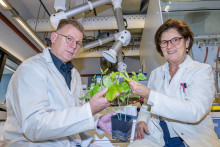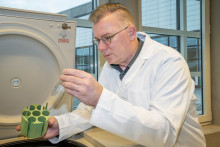‘These bean plants supply us with the virus proteins we use for our research’, Technician Regine van der Hee says, while she picks up some plants from a tray and brings them into the lab. Despite being infected with a mosaic virus, the three-week-old plants look surprisingly healthy. Only some leaves show a yellowish discoloration in a patchy, mosaic-like pattern.
The plants are a great help to get enough virus for Cornelissen’s research. ‘We infect the plant with the mosaic virus when it’s about a week old by rubbing a mixture of infected plant material and very fine sand on the leaves’, Cornelissen explains. ‘This way, we mimic the natural infection when the wind rubs leaves of infected plants against those of healthy plants.’
After infection, the virus multiplies inside the plant and already after two weeks, the plants can be harvested to extract the virus. A rather straightforward process, where step-wise centrifugation eventually isolates the virus from homogenized plants. Van der Hee: ‘From one kilogram of plant material, we manage to extract at least about 100 milligrams of virus, enough to obtain quite a few protein casings for our experiments.’

Unique protein structures
Protein casings are hollow, nano-scale protein structures where an empty space is enveloped by a protein mantle. They can be used to wrap and protect a variety of compounds, including nanoparticles or medication, since the protein mantle shields the content from the outside world, protecting it and avoiding degradation.
Such protein envelopes may be manufactured by using individual proteins to engineer these into the desired shape, or by isolating them from, for example, viruses, like Cornelissen and his team are currently doing. After isolation, these virus proteins can be manipulated to a desired size and shape and offer great potential for delivering medication at specific locations.
Fundamental research
Jeroen Cornelissen has been working with proteins for over a decade, trying to build bigger, unique protein structures with possibly unique applications. Viruses caught his attention already at an early stage of his fundamental research. Viruses are simple entities consisting of genetic material, most often RNA, that is encapsulated by a protein casing.
‘For the studied plant virus, this casing always consists of exactly 180 individual proteins, arranged in a regular chicken wire pattern’, Cornelissen explains. ‘We used this design to start building protein molds and applications were quite promising. Inside these molds we could grow and create nanoparticles of exactly the same size. This consistency in size and shape is crucial, since these determine the properties of nanoparticles.’ During this basic research, Cornelissen and his colleagues learned more about the make-up and behavior of virus protein casings. How did the usually round shape develop and which physical and chemical processes played a role?

To increase their understanding of the underlying crucial mechanisms, the scientists started to experiment with assembling protein structures in a test tube. When isolating the protein building blocks and manipulating the conditions, empty protein spheres could be easily created. Cornelissen: ‘We learned that by changing pH and salinity, such protein spheres formed spontaneously. The idea was born that we could apply this knowledge to manipulate the virus protein casing’s size and shape. These can then be used to encapsulate a wide variety of substances of various shapes, like nanoparticles, but also medication and crop protection substances.’
Folding DNA molecules
One of the basic principles that keeps a virus in shape are electrostatic forces that stabilize the individual casing proteins due to the attracting, opposite charges. But these forces also influence the electrostatic attraction between the protein casing and the genetic material, RNA or DNA, inside the virus.
‘The inside of the protein casing is positively charged, while the genetic material has a negative charge’, Cornelissen explains. ‘This interaction is crucial to keep the virus intact.’ As they learned from their previous research, changing pH and salinity could change the electrostatic forces, separating the protein from the RNA. The scientists were particularly interested in to what extent the resulting protein casings could be adapted to package differently-shaped materials.

They tested this by precisely folding DNA molecules into different shapes, so they could be used as a mold. ‘This is very much like origami, where a flat piece of paper is folded into a three-dimensional shape’, Cornelissen explains. ‘By applying the right pH and salt concentrations, we could manipulate the electrostatic forces between the DNA mold and the virus protein in such a way that the protein casing spontaneously wrapped around the differently shaped DNA molds.’
Robust assemblage
The protein casing’s remarkable flexibility, opened doors to construct them in a variety of shapes, by adapting the shape of the DNA mold: sphere- and tube-shaped DNA could be wrapped effectively by the protein casings. ‘We even managed to assemble a donut shape’, Cornelissen says. ‘This illustrates how robust the assemblage actually is.’
By using a so-called cryogenic electron microscope, the scientists could visualize the different shapes that were formed. Application of these different shapes in medical diagnostics and therapies is very promising for example, to deliver drugs at specific locations. Since the shape determines how easily such a nanoparticle can enter the cell, rods can penetrate a cell more effectively than spheres, the efficiency and speed of drug delivery can also be tuned.
Designing protein casings
For now, the scientists are working with virus protein casings, but in the future, they intend to start designing and building protein casings from scratch, by engineering protein building blocks into the desired shape and size. Thanks to their previous research, the experience is there.
These manufactured protein casings could have even more medical applications. ‘We could incorporate pH-sensitive plastic parts in the casing wall, that will dissolve when the environment is more acidic’, Cornelissen explains. ‘This can be a powerful tool to fight cancer: since tumors usually have a lower pH than healthy tissue; the plastic parts of the casing dissolve, and consequently it’s contents, for example an anti-tumor drug, is released at exactly the right location.’
This may change the way medication is supplied to patients and allow for a more effective treatment, with less side effects. Another application is to reduce pesticide use by delivering minute amounts of pesticides inside a virus protein casing. Cornelissen: ‘Viruses can spread very easily between plant, when the wind rubs the leaves together. Similarly, virus protein casings, filled with small amounts of pesticides, could spread effectively between plants.’
While the huge potential of virus casings is looming in the future, van der Hee has finished homogenizing the bean plants. The resulting intensely green liquid is ready to be centrifuged, to extract viruses for another series of experiments.







